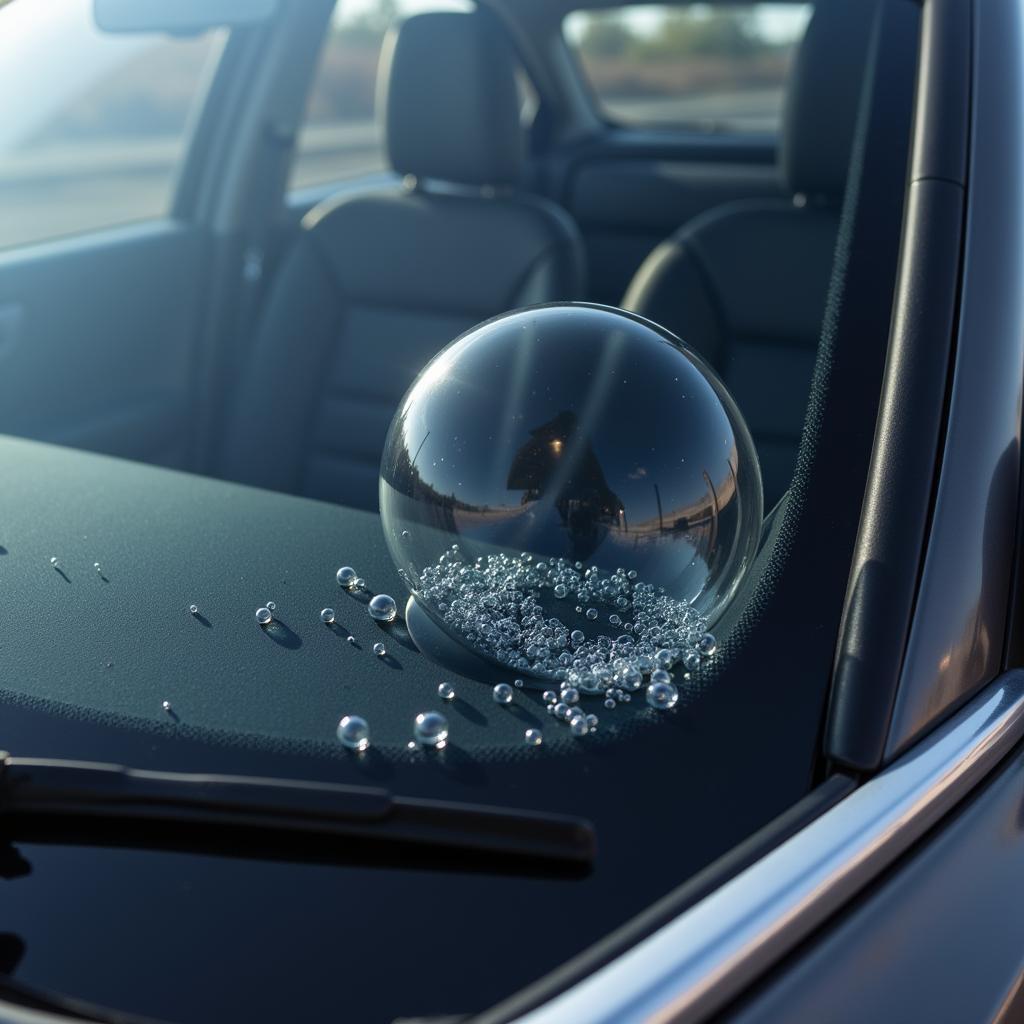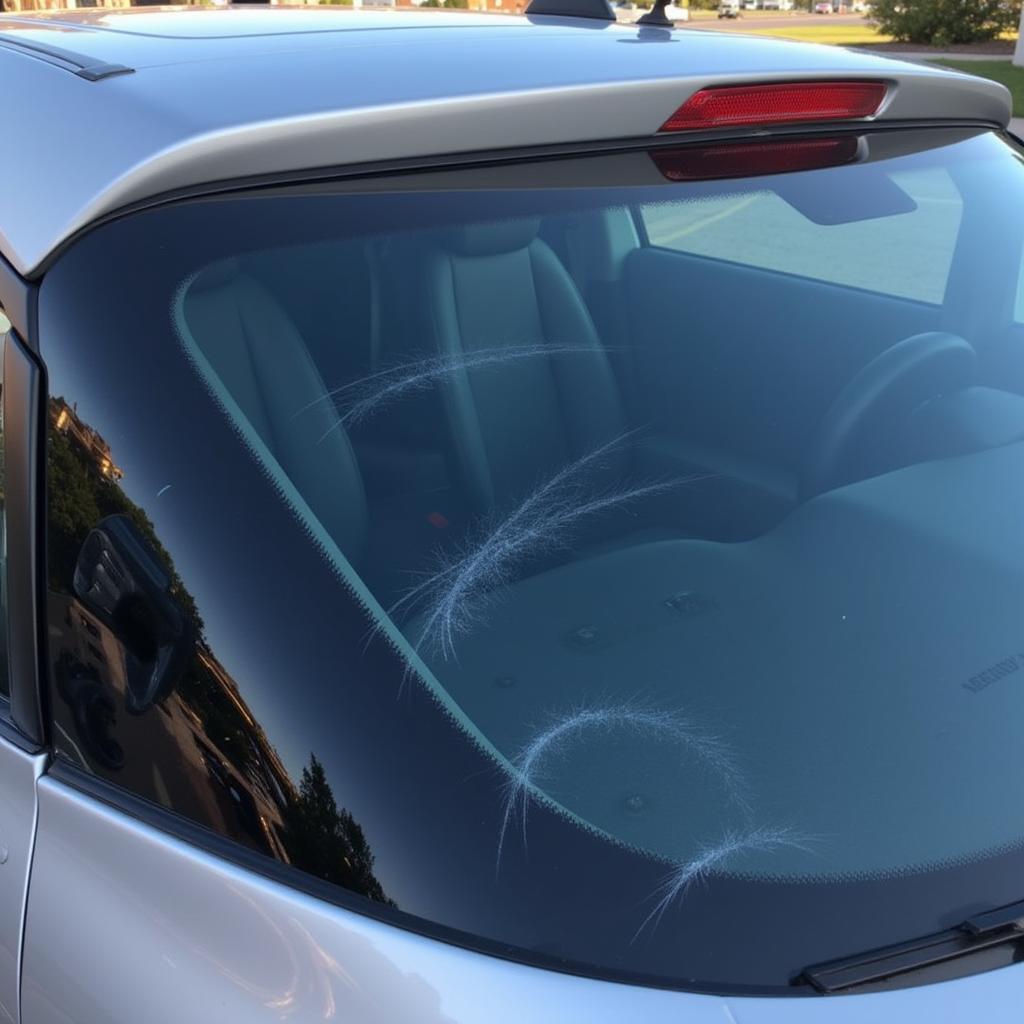Fixing car window tint issues can be a DIY project if you’re careful and patient. This guide will cover common problems like bubbles, peeling, and scratches, and provide step-by-step instructions on How To Fix Car Window Tint.
Fixing imperfections in your car window tint can drastically improve the look of your vehicle and maintain its resale value. Whether it’s bubbling, peeling, or a small tear, addressing these issues promptly can prevent further damage and save you the cost of a complete retint. But how exactly do you fix car window tint? Let’s dive in.
Common Car Window Tint Problems
Several issues can plague your car window tint, from minor annoyances to major eyesores. Recognizing the problem is the first step towards finding the right fix.
Bubbling Tint
 Car Window Tint with Air Bubbles
Car Window Tint with Air Bubbles
Bubbles are perhaps the most frequent issue, often appearing shortly after installation. They occur when air or moisture gets trapped between the film and the window. While small bubbles might disappear on their own, larger ones require intervention. A simple solution can be using a heat gun or hairdryer and a squeegee to gently push out the trapped air. If the bubbles persist, you may need to use a small needle to puncture them and release the air. [how to fix car window tinting film](https://autotippro.com/how-to fix-car-window-tinting-film/) offers a comprehensive guide on this process.
Peeling Tint
Peeling tint is another common problem, often caused by poor installation, low-quality film, or exposure to harsh elements. This can make your car look unkempt and even obstruct your vision. You can sometimes re-adhere the peeling tint using a specialized adhesive. However, if the peeling is extensive, replacing the affected section or the entire tint might be necessary. fix car window tint provides several DIY solutions for this problem.
Scratched Tint
 Scratched Car Window Tint
Scratched Car Window Tint
Scratches on your window tint can occur from various sources, such as abrasive cleaning materials or accidental contact with sharp objects. While minor scratches might be barely noticeable, deeper ones can impair visibility. Depending on the severity, you can try using a specialized tint film scratch remover. In cases of significant damage, replacing the tint is usually the best option. For more information on how to address a tear in your window tint, see how to fix a tear in car window tint.
How to Fix Minor Tint Issues
For minor bubbles or peeling, you can often fix the issue yourself. Here’s a step-by-step guide:
- Clean the affected area thoroughly with a mild soap and water solution.
- Use a heat gun or hairdryer on a low setting to warm the tint.
- Gently press the tint against the window with a squeegee, working from the center outwards.
- For persistent bubbles, carefully puncture them with a small needle and then squeegee out the air.
When to Call a Professional
While minor fixes can be DIY projects, more complex issues might require professional intervention. If you’re unsure how to proceed, or the damage is extensive, it’s best to consult a professional window tinting service.
“Proper installation is key to preventing future tint problems,” says John Smith, a certified automotive window tint specialist with over 20 years of experience. “DIY fixes are fine for minor issues, but for larger problems or complete replacements, it’s always best to seek professional help.”
Conclusion
Knowing how to fix car window tint can save you money and keep your car looking its best. While minor fixes can be tackled at home, remember that professional help is always available for more significant issues. Maintaining your window tint properly can significantly extend its lifespan and keep your vehicle looking sharp. Don’t hesitate to contact us at AutoTipPro at +1 (641) 206-8880 or visit our office at 500 N St Mary’s St, San Antonio, TX 78205, United States for expert advice and assistance with your car window tint needs. fix car widow tinting provides further information.
While dealing with car window tint issues can be frustrating, it’s important to address them promptly. By following these tips, you can keep your tint in good condition and enjoy its benefits for years to come.
“Regularly cleaning your tinted windows with a non-abrasive cleaner and avoiding sharp objects can help prevent scratches and damage,” adds Jane Doe, another seasoned automotive expert. “Preventive measures are always the best approach.”
FAQ
-
Can I use regular household cleaners on tinted windows? No, avoid using ammonia-based cleaners, which can damage the tint film. Use a mild soap and water solution or a specialized tint cleaner.
-
How long should I wait before rolling down my tinted windows? Typically, wait at least 24-72 hours, depending on the type of tint and weather conditions.
-
Why is my tint turning purple? Purple tint is often a sign of low-quality film that is deteriorating due to UV exposure.
-
Can I remove window tint myself? Yes, but it can be a tedious process. Specialized tools and techniques can make the removal easier and prevent damage to the window. Consider how to fix bubble in car tire for unrelated tire issues.
-
How much does it cost to replace car window tint? The cost varies depending on the type of film, the size of the vehicle, and the location. Obtain quotes from reputable installers to get an accurate estimate.
-
What is the best way to prevent bubbles in newly installed tint? Professional installation is the best way to prevent bubbles. Experienced installers use proper techniques to ensure a smooth and bubble-free application.
-
How can I tell if my car window tint is scratched or just dirty? Cleaning the window thoroughly will reveal whether the marks are scratches or surface dirt. Scratches will remain visible even after cleaning.




Leave a Reply